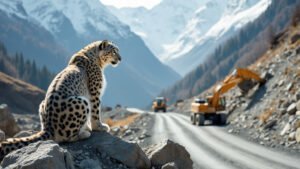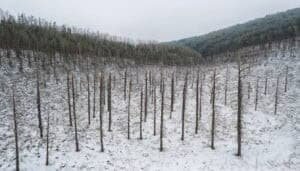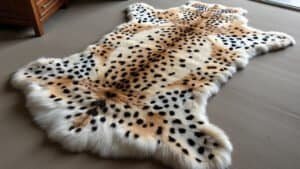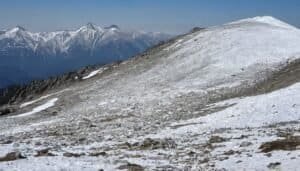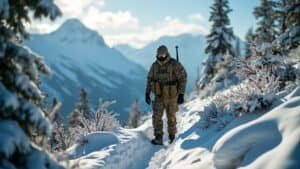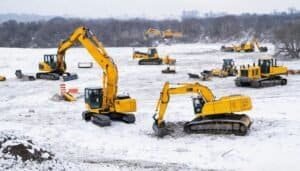Introduction
Livestock grazing in snow leopard habitats presents a complex challenge to the survival of this elusive big cat. The presence of livestock can alter prey availability, degrade habitats, and lead to increased human-wildlife conflicts, all of which pose significant threats to snow leopard populations
This article will explore how livestock grazing affects snow leopard survival, examining the impacts on prey species, habitat integrity, competition between livestock and snow leopards, and the behavioral changes that result from these pressures
Additionally, we will discuss conservation strategies designed to mitigate these effects and support the long-term survival of snow leopards
How Livestock Grazing Alters Snow Leopard Prey Availability
Livestock grazing has a profound impact on the prey availability for snow leopards, a critical factor in their survival. Snow leopards primarily prey on wild ungulates such as blue sheep (bharal), ibex, and argali, which are also essential to the ecosystem’s balance
However, when livestock are introduced into these habitats, competition for grazing land intensifies. Domestic animals, particularly sheep, goats, and yaks, consume the vegetation that wild ungulates rely on, leading to a decrease in the population of these natural prey species
This reduction in prey availability forces snow leopards to adapt in ways that can threaten their survival. In many cases, snow leopards turn to preying on livestock, which not only disrupts their natural hunting behaviors but also leads to increased human-wildlife conflicts
Studies have shown that in areas with heavy livestock grazing, there is a noticeable decline in wild prey populations, pushing snow leopards closer to human settlements
Impact on Primary Prey Species
The presence of livestock directly reduces the amount of forage available for wild ungulates. Research conducted by Bagchi, Mishra, and Bhatnagar (2004) in the Indian Trans-Himalaya found that in areas with high livestock density, the biomass of wild prey was significantly lower
This decrease is attributed to the competition between livestock and wild ungulates for the same limited food resources
Overgrazing by livestock can lead to habitat degradation, which further exacerbates the problem by reducing the regenerative capacity of vegetation, making it even harder for wild ungulates to recover
Competition for Food Resources
Livestock not only consume the vegetation needed by wild ungulates but also compete for space, driving these animals away from prime grazing areas
The displacement of wild prey species from their natural habitats due to livestock intrusion reduces their numbers and forces snow leopards to expand their hunting range, often into areas where human-livestock conflict is more likely
This competition for resources is a significant factor in the declining prey base for snow leopards
Changes in Snow Leopard Diet
As the availability of wild prey declines due to livestock competition, snow leopards are often left with no choice but to target domestic animals
This shift in diet can have dire consequences for both snow leopards and local communities. Predation on livestock increases the likelihood of retaliatory killings by herders, further endangering snow leopard populations
A study by Shehzad et al. (2014) in Mongolia revealed that up to 70% of the snow leopard’s diet in certain areas consisted of livestock during periods of prey scarcity. This reliance on livestock not only threatens the snow leopards but also undermines the sustainability of pastoralist livelihoods, creating a vicious cycle of conflict
Effects of Livestock Grazing on Snow Leopard Habitat
Livestock grazing has a significant impact on the habitat of snow leopards, contributing to habitat degradation, alteration of the ecosystem balance, and shifts in the territorial range of this elusive predator
Snow leopards inhabit some of the most rugged and remote mountainous regions in the world, where the delicate balance of the ecosystem is crucial for their survival
However, the introduction of livestock into these regions disrupts this balance, leading to a cascade of ecological changes that affect snow leopards directly and indirectly
Habitat Degradation and Loss
The introduction of livestock often leads to overgrazing, which depletes the natural vegetation cover that is essential for maintaining the habitat structure and function. Overgrazing results in soil erosion, reduced plant diversity, and the loss of critical vegetative cover that many species, including the snow leopard’s prey, depend on for survival
According to research by Mishra et al. (2001), in areas where livestock grazing is intense, there is a marked reduction in the quality and quantity of habitat available for wild ungulates, which subsequently affects snow leopard populations that rely on these prey species
The degradation of the habitat not only affects the availability of prey but also forces snow leopards to travel greater distances in search of food, which can lead to increased energy expenditure and reduced hunting success
Over time, this habitat loss can result in the fragmentation of snow leopard territories, isolating populations and making them more vulnerable to other threats such as poaching and climate change
Influence on Snow Leopard Territory
Livestock grazing can also influence the territorial behavior of snow leopards. As their natural prey becomes scarce, snow leopards may need to expand their territories to cover a larger area to meet their dietary needs
This territorial expansion can lead to increased encounters between snow leopards and livestock, heightening the risk of depredation incidents and subsequent retaliatory killings by herders
Moreover, the presence of livestock and herders within snow leopard territories can lead to habitat displacement, where snow leopards are forced to retreat to less optimal areas that provide fewer resources and less cover for hunting
This displacement not only affects their survival but also disrupts their breeding patterns, as the availability of suitable denning sites becomes limited
Impact on Ecosystem Balance
The disruption caused by livestock grazing extends beyond the immediate habitat of the snow leopard. It affects the entire ecosystem, leading to changes in the distribution and abundance of plant and animal species
The reduction in vegetation cover due to overgrazing can lead to a decline in biodiversity, affecting not only the prey species of snow leopards but also other wildlife that shares the same habitat
Additionally, the introduction of livestock can alter the natural predator-prey dynamics within the ecosystem. For example, the decline in wild ungulates due to competition with livestock can reduce the prey base for other predators, potentially leading to increased competition among carnivores, including snow leopards, for the remaining prey
This shift in the ecosystem balance can have long-term consequences for the survival of snow leopards and the overall health of the environment they inhabit
Competition and Conflict Between Livestock and Snow Leopards
The competition and conflict between livestock and snow leopards are central to understanding the challenges faced by these big cats in their natural habitat
As livestock numbers increase in regions traditionally dominated by wild prey species, snow leopards are forced into closer proximity with human activities, leading to direct and indirect conflicts
These conflicts not only jeopardize the survival of snow leopards but also strain relationships between local communities and conservation efforts
Direct Encounters and Depredation Events
One of the most immediate consequences of livestock grazing in snow leopard territories is the increased likelihood of direct encounters between snow leopards and livestock
Snow leopards, faced with dwindling populations of their natural prey due to competition with livestock, often turn to domestic animals as a food source. This predation on livestock leads to significant economic losses for herders, who depend on their animals for livelihood
Research by Jackson and Wangchuk (2004) highlights that in many regions where snow leopards are found, livestock depredation accounts for a significant portion of the snow leopard’s diet, particularly in areas where natural prey is scarce
These depredation events can lead to a cycle of retaliatory killings, where herders, in an effort to protect their livestock, resort to killing snow leopards, often using traps, poison, or guns
Human-Wildlife Conflict Due to Livestock Losses
The loss of livestock to snow leopards exacerbates human-wildlife conflict in mountainous regions. For many herders, livestock is not only a source of income but also a cultural and social asset, making losses particularly devastating
The frustration and economic strain caused by repeated livestock depredation can lead to negative attitudes toward snow leopard conservation, with local communities often viewing the cats as a threat rather than a species in need of protection
Li et al. (2013) found that in the Sanjiangyuan region of the Tibetan Plateau, the frequency of livestock depredation by snow leopards was directly correlated with negative perceptions of the species among herders
This antagonism poses a significant challenge for conservationists who must work to balance the needs of local communities with the imperative to protect snow leopards
Measures to Reduce Conflicts
Addressing the conflicts between snow leopards and livestock requires a multifaceted approach that involves both protecting snow leopards and mitigating the economic losses suffered by herders
One of the most effective strategies has been the implementation of community-based conservation programs that involve local people in the protection of snow leopards while also providing them with economic incentives
For example, the Snow Leopard Trust has implemented livestock insurance schemes in various regions, where herders are compensated for animals lost to snow leopards. This reduces the financial burden on herders and diminishes the likelihood of retaliatory killings. Additionally, predator-proof corrals have been introduced in several regions to protect livestock at night, a time when they are most vulnerable to snow leopard attacks
Another important measure is the promotion of alternative livelihoods for herders, which reduces their dependence on livestock and, consequently, the potential for conflict
These programs often involve training in handicrafts, eco-tourism, and other activities that can provide income without the need for large herds of livestock. By reducing the economic reliance on livestock, these initiatives help to decrease the incidence of livestock depredation and foster more positive attitudes toward snow leopard conservation
Behavioral Changes in Snow Leopards Due to Livestock Grazing
Livestock grazing not only affects the physical environment and prey availability for snow leopards but also induces significant behavioral changes in these predators
These changes are often adaptations to the pressures exerted by the presence of livestock and the resulting human activity within their territories. Understanding these behavioral shifts is crucial for developing effective conservation strategies that address the root causes of human-wildlife conflict
Alterations in Hunting Patterns
One of the most notable behavioral changes in snow leopards due to livestock grazing is the alteration in their hunting patterns. Snow leopards are primarily solitary hunters, relying on stealth and the element of surprise to capture prey
However, the presence of livestock and humans can disrupt these natural hunting behaviors. In areas where livestock grazing is prevalent, snow leopards are often forced to hunt more frequently near human settlements, where livestock has replaced their natural prey
This shift not only changes the snow leopard’s diet but also alters their hunting schedule. Instead of hunting during twilight or nighttime hours, snow leopards may adjust their activity patterns to avoid human encounters, hunting at times when human activity is minimal
This adjustment can lead to increased energy expenditure and reduced hunting efficiency, as snow leopards are pushed into less optimal hunting conditions
Effects on Snow Leopard Movement and Range
The need to adapt to the presence of livestock also affects the movement patterns and territorial range of snow leopards. In regions where livestock grazing is intense, snow leopards may expand their territories in search of sufficient prey
This territorial expansion can bring them into conflict with other snow leopards, leading to increased competition and the potential for territorial disputes
Moreover, the fragmentation of habitats due to overgrazing and human encroachment can force snow leopards to move through or inhabit areas that are less suitable for their survival
These areas may have fewer prey, less cover for stalking, and greater exposure to human threats. The resulting changes in movement patterns can disrupt snow leopard populations, making it harder for them to find mates, raise cubs, and maintain healthy population levels
Adaptations to Human Presence
In addition to changes in hunting and movement patterns, snow leopards exhibit several adaptations to cope with the increased human presence associated with livestock grazing
One such adaptation is the increased use of cover and terrain to avoid detection by humans. Snow leopards are known for their ability to blend into their surroundings, but in areas with high human activity, they may become even more reclusive, using rugged terrain and dense vegetation to avoid encounters
Another adaptation is the shift in denning behavior. Snow leopards typically choose secluded and inaccessible locations for their dens, but with the encroachment of livestock and humans, these cats may need to find even more remote or secure sites, which could impact their reproductive success
The stress of frequent human disturbance near denning sites can lead to lower cub survival rates, further endangering snow leopard populations
Additionally, snow leopards may develop a heightened sensitivity to human activity, becoming more skittish and less likely to approach areas where humans are present. This wariness can impact their ability to hunt effectively, as they may avoid prime hunting grounds near human settlements
Over time, these behavioral changes can reduce the overall fitness of snow leopard populations, making them more vulnerable to other environmental stresses, such as climate change and habitat loss
Conservation Strategies to Mitigate Livestock Grazing Impact
Mitigating the impact of livestock grazing on snow leopard survival requires a comprehensive approach that balances the needs of local communities with the conservation of these endangered big cats
Effective conservation strategies involve collaboration between local herders, conservation organizations, and governments to implement practices that reduce conflict and promote sustainable coexistence
Community-Based Conservation Efforts
Community-based conservation has proven to be one of the most effective strategies in reducing the negative impacts of livestock grazing on snow leopards. These initiatives actively involve local communities in the conservation process, ensuring that they benefit directly from efforts to protect snow leopards
One successful example is the Snow Leopard Conservancy’s community-based programs, which work with local herders to implement practices that reduce livestock losses to snow leopards while promoting snow leopard conservation
These programs often include training in livestock management practices that reduce the likelihood of predation, such as the construction of predator-proof corrals and the implementation of better herding practices
Additionally, these programs may involve educational components that raise awareness about the importance of snow leopard conservation and the role of healthy ecosystems in supporting local livelihoods
Livestock Management Practices
Improving livestock management practices is another critical strategy for mitigating the impact of grazing on snow leopards. By enhancing the security of livestock, the likelihood of depredation is reduced, which in turn decreases the motivation for retaliatory killings
One effective practice is the use of predator-proof corrals, which are designed to protect livestock at night when they are most vulnerable to snow leopard attacks
Another important practice is rotational grazing, which involves moving livestock between different pastures to prevent overgrazing and allow vegetation to recover. This approach not only helps maintain the quality of the habitat but also reduces competition between livestock and wild ungulates, thereby supporting the prey base for snow leopards
Additionally, reducing livestock density in critical snow leopard habitats can help alleviate the pressure on these ecosystems and allow for the regeneration of natural vegetation
Policy Recommendations and Implementation
Government policies play a crucial role in supporting conservation efforts and ensuring that livestock grazing practices do not threaten snow leopard populations
Effective policies may include the establishment of protected areas where livestock grazing is limited or prohibited, providing safe havens for snow leopards and their prey. Additionally, policies that promote sustainable grazing practices and provide incentives for herders to adopt conservation-friendly practices are essential
In regions where snow leopard habitats overlap with livestock grazing areas, governments can implement compensation programs that reimburse herders for livestock lost to predation
These programs can reduce the financial burden on herders and discourage retaliatory killings. Moreover, policies that support the diversification of income sources for herders, such as eco-tourism or handicrafts, can reduce the reliance on livestock and thereby reduce grazing pressure on snow leopard habitats
International cooperation is also vital, as snow leopards inhabit a range of countries across Central and South Asia. Transboundary conservation initiatives that facilitate collaboration between neighboring countries can enhance the protection of snow leopard habitats and ensure that conservation efforts are coordinated across the species’ range
Organizations like the Global Snow Leopard and Ecosystem Protection Program (GSLEP) play a key role in fostering such cooperation, bringing together governments, NGOs, and local communities to work towards the common goal of snow leopard conservation
Conclusion
The survival of snow leopards in the face of increasing livestock grazing is a complex issue that requires a multifaceted approach
Livestock grazing affects snow leopards by reducing prey availability, degrading habitats, and forcing behavioral changes that can compromise their survival. These pressures are exacerbated by direct competition with livestock and resulting conflicts with human populations
However, through community-based conservation efforts, improved livestock management practices, and supportive government policies, it is possible to mitigate these impacts
Sustainable coexistence between snow leopards and local communities is achievable, but it requires ongoing commitment and cooperation from all stakeholders involved. By implementing these strategies, we can help ensure that snow leopards continue to thrive in their natural habitats for generations to come


